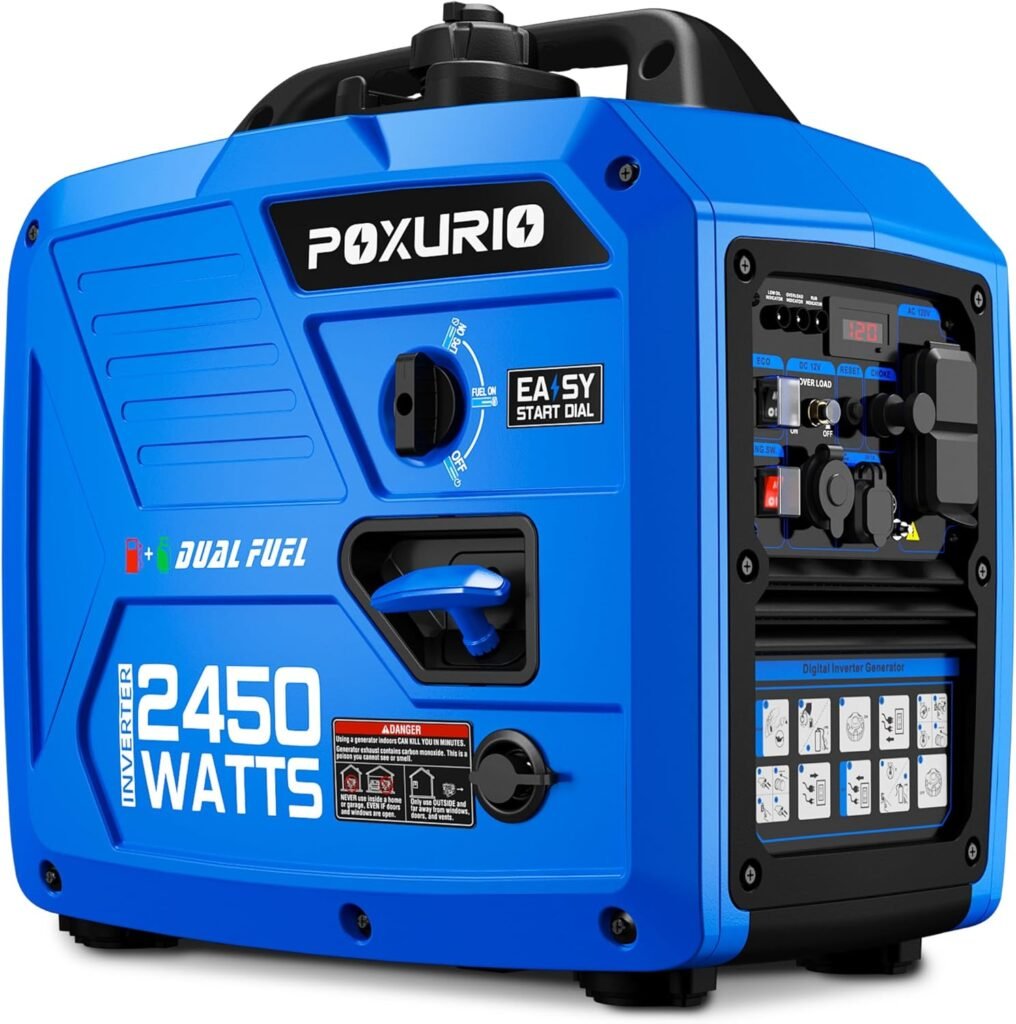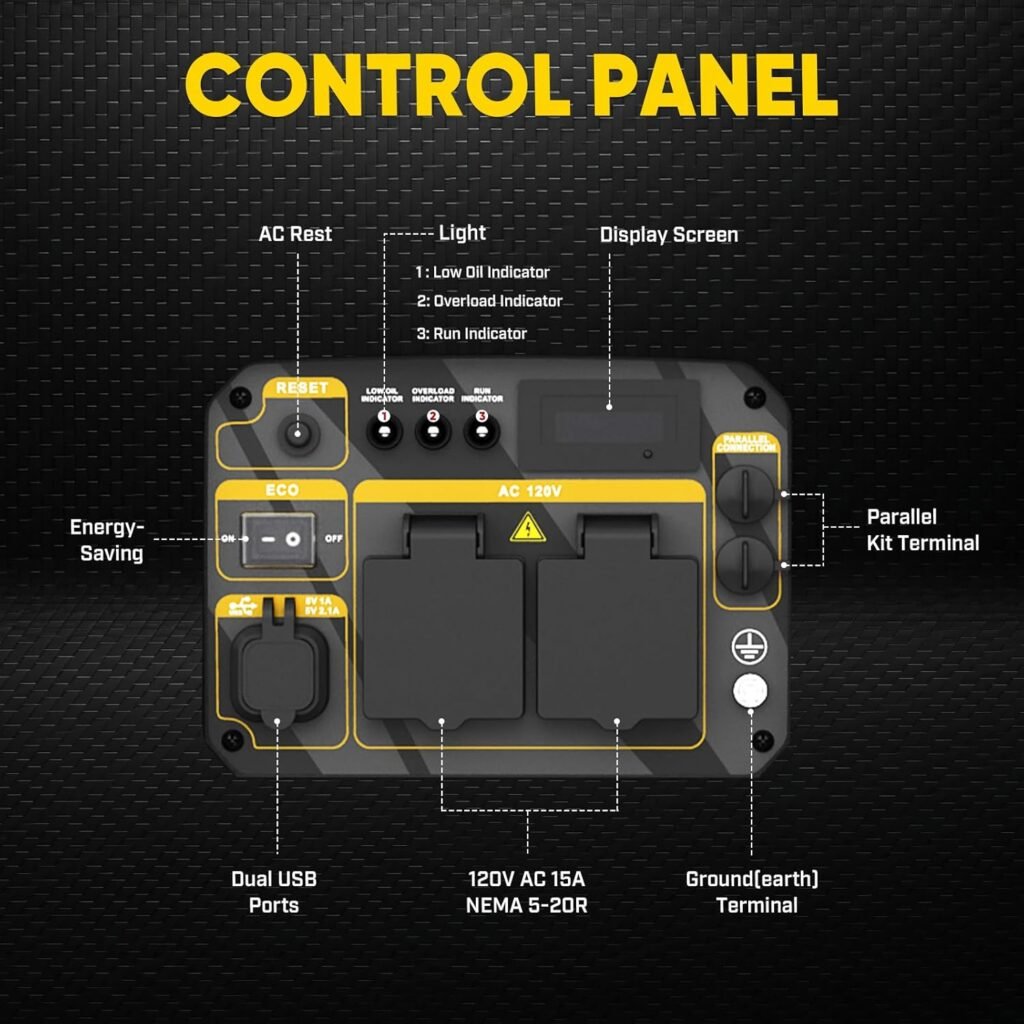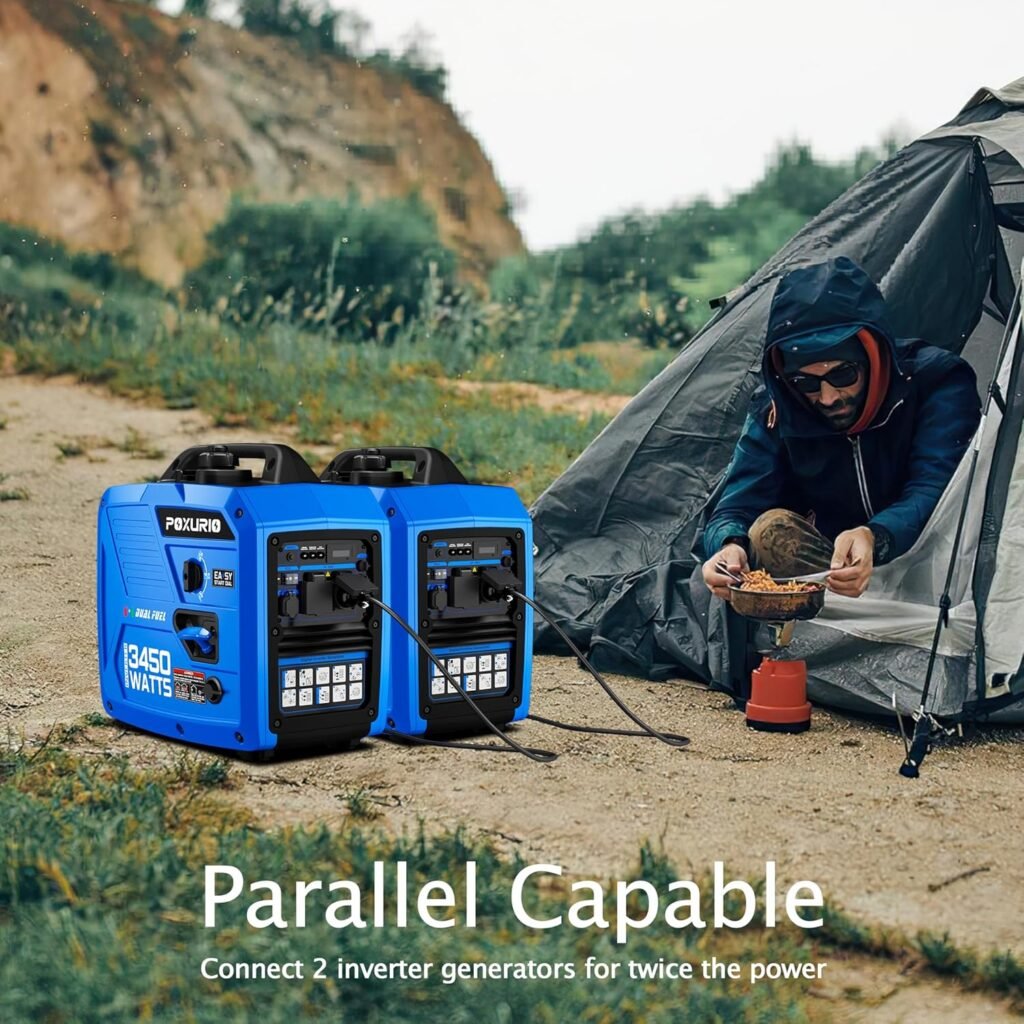
Looking for a compact, quiet generator that can run on gasoline or propane for home backup and outdoor use?
Product Snapshot
We tested the 2450-Watt Dual Fuel Inverter Generator for Home Use, 1.6Gallon Large Fuel Tank Up to 8.3 Hours Use, 120V Gas Powered Generator Super Quiet – EPA Compliant and assessed whether it matches everyday backup and outdoor power needs. The unit is advertised as an inverter generator with 2450W starting power, dual-fuel capability, a relatively large fuel tank for its size, low noise output, and EPA compliance — all attractive features for light home backup, camping, and small jobsite tasks.
Key Specifications
We like to see specs laid out clearly before making a purchase decision, so we summarized the core claims from the listing and product details. These numbers give a quick picture of what the generator promises and where we’ll need to ask questions or verify performance.
| Feature | Specification / Claim |
|---|---|
| Product Name | 2450-Watt Dual Fuel Inverter Generator for Home Use, 1.6Gallon Large Fuel Tank Up to 8.3 Hours Use, 120V Gas Powered Generator Super Quiet – EPA Compliant |
| Starting Power | 2450W (advertised starting wattage) |
| Fuel Type | Dual fuel: Gasoline and Propane |
| Fuel Tank Capacity | 1.6 gallons (6L, as noted in product details) |
| Claimed Runtime | Up to 8.3 hours (product name) / Up to 14 hours at 25% load (product details) |
| Noise Level | 59 dB during operation (advertised) |
| Weight | ~43 pounds (lightweight materials) |
| Output Voltage | 120V (inverter output suitable for sensitive electronics) |
| Emissions/Compliance | EPA compliant |
| Use Cases | Home backup, camping, outdoor activities, light commercial use |
Performance and Power Delivery
We focused on how the generator handles both surge (starting) loads and continuous operation since that determines what appliances and tools we can reliably run. The listed starting power of 2450W suggests it can handle initial surges from motors and compressors, but continuous/rated output is not explicitly stated in the supplied text.
How Much Power Can We Expect Continuously?
We want to be realistic: many inverter generators that advertise a 2450W starting or surge capability often have a continuous output in the 2000W to 2200W range, depending on engine tuning and cooling. For our planning, we treat the 2450W as the peak start-up capability and recommend checking the seller’s full spec sheet or manual for the official rated watts before relying on it to run multiple high-draw appliances simultaneously.
Handling Appliances, Motors, and Sensitive Electronics
With an inverter design and 120V clean power output, we expect the unit to provide stable voltage and frequency suitable for laptops, phones, TVs, and other sensitive electronics. For motor-driven appliances — refrigerators, well pumps, or power tools — the starting (surge) watt requirement can be several times the running wattage. Given the 2450W surge rating, we can typically start a small refrigerator and run a few lower-power devices, but we should avoid trying to run a whole-house HVAC system or large electric range simultaneously.
What Appliances Can We Run?
We want to be practical about typical loads so we can match our needs to what the generator can actually support. The examples below are common reference points when planning loads for a unit in this class.
- LED TV: ~50–200W — easily supported.
- Laptop/Phone chargers: ~50–100W combined — trivial for this unit.
- Mini fridge: Start ~600–1200W, run ~100–300W — usually manageable.
- Sump pump (small): Start ~800–1500W, run ~400–800W — may be possible if no other heavy loads run concurrently.
- Microwave: Start/run ~800–1500W — possible but may limit other appliances.
- Window AC (5,000–8,000 BTU): Start ~1200–2000W, run ~600–1500W — borderline and depends on exact model and simultaneous loads.
- Power tools (drills, saws): Variable; most small tools will be ok for intermittent use, but heavy continuous loads may be too much.
We recommend mapping out the wattage of each appliance and adding a safety margin to ensure the generator isn’t overloaded at any point.
Fuel System and Runtime
Fuel flexibility is a major benefit of a dual-fuel inverter generator, and we paid attention to the fuel tank size and runtime claims. The product listing contains two different runtime figures: the product name states up to 8.3 hours, while the product details claim up to 14 hours at 25% load with the 6L (1.6 gallon) tank. We interpret this as variations based on load and testing conditions.
Understanding the Runtime Claims
Our practical takeaway is that runtime depends heavily on load. The “up to 14 hours at 25% loading” claim implies very light use (e.g., charging electronics and running LED lights) and favorable testing conditions. The “up to 8.3 hours” figure in the product name is likely a conservative real-world estimate under moderate loads. For heavier loads, runtime will be significantly less. We recommend planning for the longer runtime only when using small loads and keeping expectations conservative for mixed or heavier loads.
Propane vs Gasoline: Pros and Cons
We appreciate the dual-fuel option because it gives flexibility:
- Propane: Cleaner burning, longer shelf life for fuel, easier storage; however, energy density is lower so runtime per gallon-equivalent is typically less than gasoline.
- Gasoline: Higher energy density and often better runtime per tank, but it degrades over months and must be stabilized or drained for long-term storage.
We advise practicing switching between fuels before relying on the generator in an emergency so we’re familiar with the process and any differences in starting behavior.
Fuel Efficiency and Practical Tips
Maintaining fuel quality and following best practices extends runtime and prevents damage. We noticed the product details recommend “pour out the oil” if not planning to use it later — which we interpret as advice to drain or stabilize fuel for storage. We suggest following standard small-engine storage procedures.
Storage and Long-Term Care
When storing the generator for extended periods, we recommend:
- Running the carburetor dry or using a fuel stabilizer to prevent varnish buildup.
- Changing the engine oil as recommended in the manual before storage.
- Removing or stabilizing gasoline if storage will exceed a month or two.
- Storing propane tanks outdoors in accordance with safety rules.
These steps will help preserve engine life and ensure the generator starts reliably after a storage period.
Noise Level and Portability
Noise and portability matter especially if we’re using the generator at campsites, neighborhood events, or close to a house. The listing advertises a noise level of only 59 dB during operation, which is considerably quieter than many conventional generators.
How Quiet Is 59 dB in Practice?
A 59 dB reading is roughly equivalent to a normal conversation at a few feet away or background office noise. In our experience, that level is unobtrusive at moderate distances and will not upset neighbors as quickly as louder traditional units. However, noise perception depends on surroundings — inside enclosed spaces, near windows, or in quiet rural areas, the unit will still be noticeable, so we should be considerate when placing it near others.
Portability: Weight and Handling
At roughly 43 pounds and described as built from lightweight materials, this generator is manageable for one or two people to transport. The relatively low weight makes it a good choice for camping trips, tailgates, or moving between storage and work areas. We recommend using a cart or two-person carry technique for longer hauls to reduce strain.
Design and Build Quality
We paid attention to construction and features that affect daily use and longevity. The inverter topology and the EPA compliance are positive indications for both power quality and emissions.
Controls, Access, and Design Details
While the available information confirms inverter technology and 120V output, outlet types and control layout were not exhaustively detailed in the product text we received. We recommend checking the seller photos or manual for the exact outlet mix (GFCI protection, 120V AC receptacles, DC outlets, USB ports) and whether it includes electric start or recoil start mechanisms. These details impact convenience and compatibility with devices.
Emissions and Certification
EPA compliance means the unit meets certain emissions standards, which is important if we plan to use it in regulated areas or rely on it frequently. We also appreciate the cleaner operation associated with inverter designs, which can produce cleaner sine wave output suitable for sensitive electronics.
Outlets and Electronics Compatibility
We value an inverter generator primarily for its stable power output that is safe for electronics. The product promises 120V inverter output, which generally produces stable voltage and lower total harmonic distortion (THD).
Using the Generator with Laptops, Routers, and TVs
Because of the inverter design, we feel comfortable using the generator to run laptops, Wi-Fi routers, game consoles, and TVs without risking premature damage from power spikes. We still suggest confirming the THD rating (if listed) and not chaining critical medical devices unless explicitly supported and appropriate for the generator’s output capacity.
Confirming Outlet Options
Before buying, we encourage checking whether the unit includes the outlets we need: standard 120V household-style outlets, a 12V DC output, or dedicated locking connectors. If you need parallel capability to link another unit for higher power, verify whether the model supports that.
Safety and Compliance
We take safety seriously and highlight practices to keep our households and communities safe while using portable generators.
Ventilation, CO Safety, and Placement
Generators emit carbon monoxide and should always run outside, away from doors, windows, and vents. We recommend placing the generator on a stable, level surface and keeping it at least 10–20 feet from occupied structures depending on local guidance. Installing a battery-powered CO alarm in the home adds an extra layer of protection.
Grounding and Electrical Safety
Follow the manufacturer’s manual for grounding instructions and never plug a generator directly into household wiring without a properly installed transfer switch. Using proper extension cords rated for outdoor use and the appliance’s amperage ensures safe transfer of power. If in doubt, consult a licensed electrician for installations that tie into a home panel.
Pros and Cons
We boiled down the main strengths and trade-offs we observed based on the product claims and typical behavior for similar units.
Pros
- Dual-fuel capability gives flexibility and easier fuel storage options.
- Advertised 2450W starting power handles many small motors and appliances.
- Inverter design provides cleaner power for sensitive electronics.
- Low advertised noise level (59 dB) makes it less intrusive.
- Lightweight (~43 pounds) and portable for camping and transport.
- EPA compliance for emissions standards.
Cons
- The listed runtime values are inconsistent (8.3 hours vs 14 hours), so actual performance will vary by load and conditions.
- Exact rated/continuous wattage and outlet configuration were not specified in the supplied text — we recommend verifying these details.
- Propane runtime is typically lower than gasoline, meaning an extended outage could require extra fuel planning.
- No specific mention of electric start, parallel capability, or comprehensive outlet list in the provided details.
Comparison with Similar Models
We compared the main characteristics to what we’d expect from similar inverter generators in the 2000–3000W class. This helps us know whether the unit offers good value relative to alternatives.
How It Stacks Up
Compared to other inverter generators around 2000–3000W:
- Noise: The 59 dB claim puts it on the quieter end of the spectrum, which is a strong selling point.
- Weight: At ~43 pounds, it’s lighter than many rivals with similar power, improving portability.
- Fuel Flexibility: Dual-fuel is a competitive advantage in this class, where many units are gasoline-only.
- Runtime: The mixed runtime claims mean we’d want to verify expected operating time under typical loads, as some competitors offer well-documented run times at various loads.
We recommend comparing outlet types, warranty coverage, and real-world customer feedback when choosing between models.
Maintenance and Troubleshooting
Maintaining a small inverter generator keeps it reliable in emergencies and extends its lifespan, so we outline routine tasks and quick fixes for common issues.
Routine Maintenance Tasks
- Change engine oil according to the interval in the manual (typically after first several hours and then every 50–100 hours depending on use).
- Clean or replace the air filter periodically to maintain airflow.
- Replace the spark plug annually or per recommended hours.
- Stabilize or drain fuel if you won’t be using the generator for a month or more.
- Inspect fuel lines and seals for leaks or deterioration.
Troubleshooting Common Issues
- Hard starting or no start: Check fuel supply, fuel valve position, choke setting (if applicable), and spark plug condition. If running on propane, confirm proper hose/connection and that the tank valve is open.
- Low power or stalling: Verify fuel level, air filter cleanliness, and correct oil level. Overload is another common cause — reduce load and try again.
- Excessive vibration/noise: Check for loose mounting bolts, damaged muffler components, or exhaust obstructions.
If problems persist beyond basic troubleshooting, we recommend contacting dealer support or a qualified small-engine technician to prevent further damage.
Practical Use Cases and Scenarios
We laid out realistic scenarios where this generator will shine, and where it may reach its limits, so we can make an informed decision based on our needs.
Best Use Cases
- Camping and tailgating: Lightweight, fairly quiet operation and dual-fuel flexibility make it well-suited for outdoor recreation.
- Light home backup: Powering refrigerator, lights, and a few essentials during short outages — especially if we plan loads carefully.
- Small jobsite tasks: Powering small tools intermittently where portability and moderate power are needed.
When to Look for a Larger Unit
- Whole-house backup: If we need to run central HVAC, electric water heaters, or multiple major appliances simultaneously, we should select a larger capacity or standby generator.
- Extended high-load operation: For continuous heavy loads over long durations, a unit with higher rated continuous watts and larger fuel capacity will be more suitable.
Value and Warranty Considerations
We considered whether the generator’s features justify the likely price range and what to check regarding warranty and support.
Assessing Value
If the unit delivers on its advertised noise level, dual-fuel capability, and portability, it represents a strong option for users who need a balance of quiet operation and moderate power. The inverter technology and EPA compliance add tangible value for electronics users and environmentally conscious buyers.
Warranty and After-Sales Support
We advise confirming the manufacturer’s warranty details, included support services, and availability of replacement parts (filters, spark plugs, carburetor kits). Good after-sales support can make a big difference in long-term ownership satisfaction.
Final Recommendation
After reviewing the advertised features and practical implications, we find that the 2450-Watt Dual Fuel Inverter Generator for Home Use, 1.6Gallon Large Fuel Tank Up to 8.3 Hours Use, 120V Gas Powered Generator Super Quiet – EPA Compliant is a compelling option for people who need a portable, relatively quiet generator for camping, light jobsite use, or emergency home backup.
We recommend this generator for:
- Families who want backup power for essential appliances and electronics during short outages.
- Campers and recreational users who prioritize portability and quiet operation.
- Users who value the flexibility of running on propane or gasoline.
We recommend verifying these final points before purchase:
- Confirm the continuous/rated wattage and specific outlet configuration for your devices.
- Check the precise runtime figures for typical loads you expect to run.
- Review warranty terms and availability of replacement parts.
If we keep our expectations aligned with the unit’s class — moderate continuous power, strong surge capability, and good portability — this generator should give solid, quiet performance for everyday backup and outdoor needs.
Disclosure: As an Amazon Associate, I earn from qualifying purchases.




